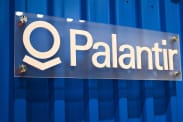
Among companies up more than 300% this year is Carvana, known for its dozens of car vending machines and zero years of profitability.
Justin Sullivan/Getty ImagesI’m not a futurist, but investors looking for the next powerful return driver beyond artificial intelligence might want to check out ball bearings and slushies. Small companies are due for a lift—maybe a yearslong one. Below are some top picks from a pair of money managers.
It has been a suspiciously good year for an uncomfortably narrow group. The S&P 500 index is up 18% year to date, and trades at 21 times this year’s projected earnings. Gains have overwhelmingly come from tech behemoths with early AI leads. Three have more than doubled this year: Nvidia (ticker: NVDA), Meta Platforms (META), and Tesla (TSLA).
The rally should be broadening about now. But investors seem to have passed over sturdy, small companies and gone straight for a Star Wars cantina of market oddities. Among companies up more than 300% this year are Carvana (CVNA), known for its dozens of car vending machines and zero years of profitability, crypto mining concerns Riot Platforms (RIOT) and Marathon Digital Holdings (MARA), and Upstart Holdings (UPST), an AI-driven lender.
I’m no expert on late-cycle, postpandemic, pre-election-year asset rotations amid historic interest-rate hikes, a severe yield curve inversion, and the ocean nearing fondue temperatures. But isn’t the S&P SmallCap 600 worth a look? It contains companies that you think you might have heard of but aren’t sure, like audio player Knowles (KN) and adhesives specialist H.B. Fuller (FUL), as well as ones that everyone knows, like Dave & Buster’s Entertainment (PLAY), where parents down giant drinks while kids burn through their videogame cards.
The S&P 600 index is up only half as much as the S&P 500 this year, and trades at 15 times earnings. In a recent analysis of Russell large- and small-cap indexes, BofA Securities calculated that small companies are 30% cheaper than usual relative to big ones. Over the next decade, it reckons, small-caps are poised to gain an average of 11% a year, versus 4% for large-caps.
One knock on small companies is that they’re more sensitive to economic downturns than large ones. But that’s already reflected in the 16% earnings decline projected for the S&P 600 this year, versus a 1% earnings increase for the 500. Using either last year’s earnings for the 600, or next year’s projected earnings bounce back, the valuation is closer to 13 times earnings.
Brad Neuman, director of market strategy at Alger, which is known for growth funds, says that small-caps have underperformed by the most in two decades, and that the last time that happened, they went on to outperform by nearly 50 points over five years. He also says that it’s easier to be a small-cap manager than a large-cap one—there’s more room to differentiate portfolios, and with analyst coverage relatively sparse, there’s a bigger payoff for investor research.
One of Neuman’s favorite stocks now is PROS Holdings (PRO). It was an early player in using computing power to adjust flight prices on the fly to maximize revenue, and today uses AI to optimize pricing for 30 industries. The company says that typical customers see gains in sales and margins and a rapid return on their software spending. “That’s a lot of what Alger is looking for,” Neuman says. “Does the company that we’re looking at provide a product or service that adds a lot of value to its customers?” PROS Holdings is expected to swing from losses to a small profit this year. Most revenue comes from subscriptions. Its three-year goal is to grow revenue by 16% to 21% cumulatively, with a 19% to 24% free cash margin. Shares trade as 5.6 times revenue.
RBC Bearings (RBC) makes, well, ball bearings. But also roller bearings, thrust bearings, and journal bearings—and please don’t get me started about bushings. It sells to industrial and aerospace customers and is the sole source for many of its products. The company is more than a century old. Sales have grown at an average of 10% a year for just over a quarter-century. Barriers to entry include patents, customer certifications, and service. Shares go for 22 times projected free cash flow.
Guidewire Software (GWRE) sells software to more than 500 insurers in 38 countries. Programs handle back-office work, transactions, customer contact, and underwriting analytics. A shift from selling licenses for installed software to subscriptions for cloud-based services is masking growth and reducing profits in the near term. Long term, Neuman says that it will expand Guidewire’s competitive advantage. Last quarter, overall revenue grew just 5%, to $208 million, but the subscriptions and support component of revenue grew 24%, to $108 million. Shares trade at about seven times revenue.
Bryant VanCronkhite runs small-cap portfolios for Allspring, with an emphasis on value. He likes J&J Snack Foods (JJSF), which sells soft pretzels, Icees, ¡Hola! Churros, and more, primarily to food-service customers such as stadiums, theme parks, and movie theaters. The pandemic hit the company hard. Now, business is bouncing back. Last year, J&J bought Dippin’ Dots ice cream. It’s adding three new distribution centers and seven production lines to improve efficiency. Shares go for 40 times depressed earnings for the company’s fiscal year ending in September. Next year, Wall Street pegs earnings growth at 36%.
Air Lease (AL), at nine times earnings, is a go-between for aircraft manufacturers and airlines. VanCronkhite likes that many airlines turn to leasing to keep their balance sheets from getting bloated, and that leasing companies are a source of new aircraft at a moment when lead times on orders are long. Pricing power appears strong; the industry consolidated two years ago, when General Electric (GE) sold its air leasing business to industry leader AerCap Holdings (AER).
Euronet Worldwide (EEFT) handles money transfers, cash machines, and retail payments. VanCronkhite says that the company is growing organically and taking market share in financial technology, but that investors mistakenly price it like a travel-related business. Revenue is expected to increase by 10% this year to $3.7 billion, and the stock goes for 10 times free cash flow.
Write to Jack Hough at jack.hough@barrons.com. Follow him on Twitter and subscribe to his Barron’s Streetwise podcast.





